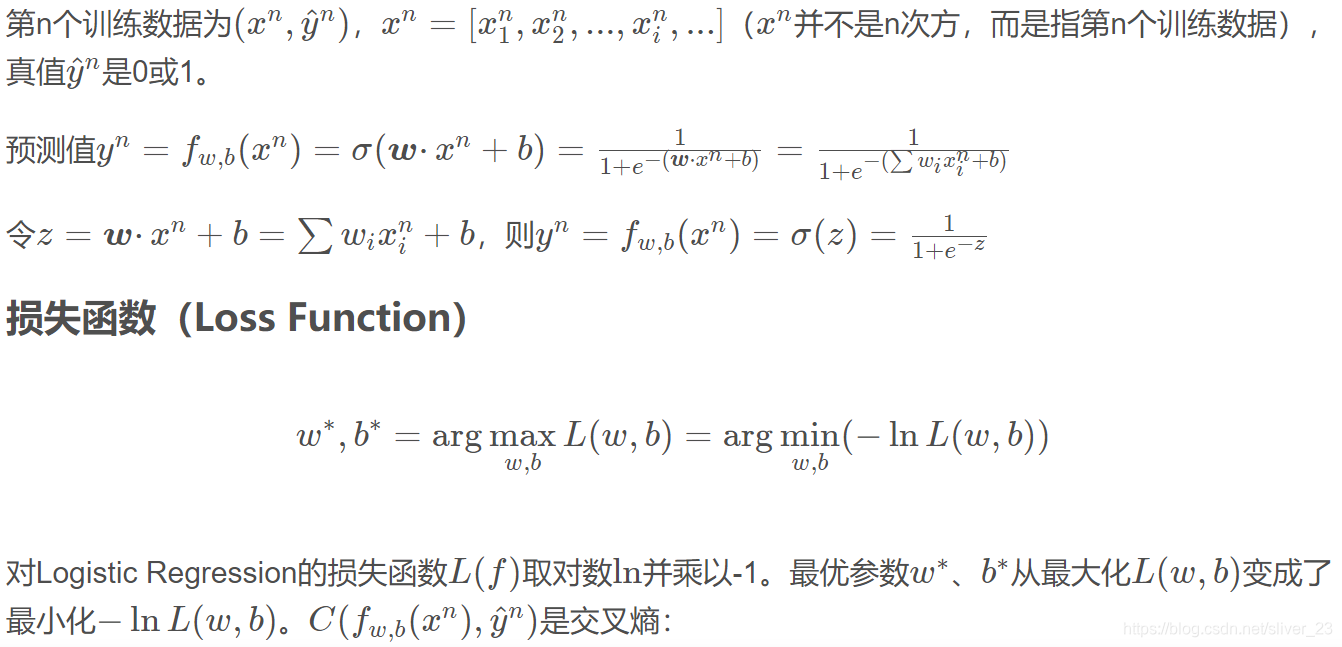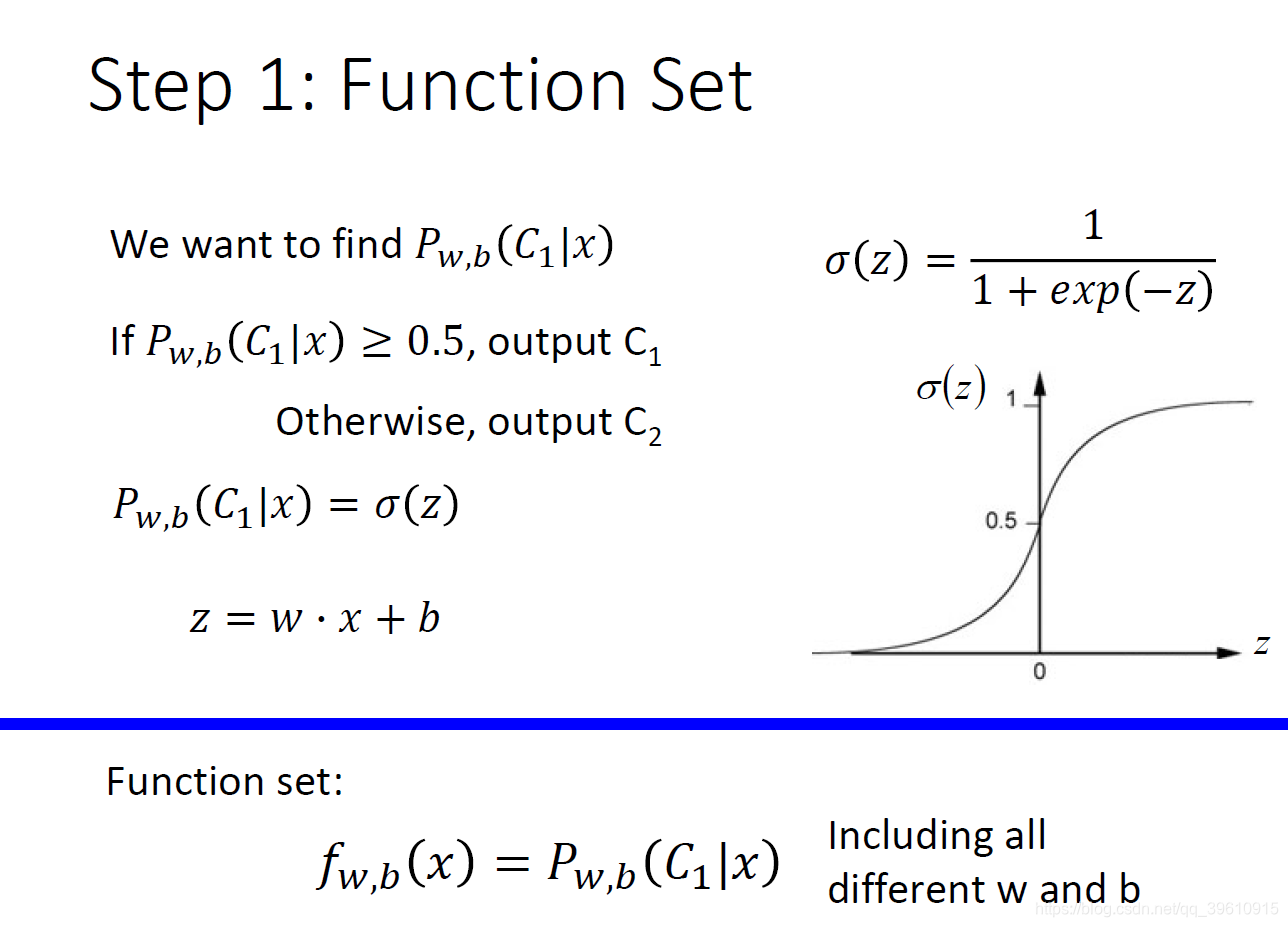目录
5.?Porbabilistic generative model 概率生成模型
1. 数据来源
链接:https://pan.baidu.com/s/1J0tSiFUTbSdprff6USf0iQ?
提取码:wc2r
一共有六个文件,实际上只需要后三个文件即可,后三个文件是老师事先帮我们将数据整理成csv格式并且全都是数字的数据。
参数共有510个。
2. 作业描述
根据提供的人们的各项资料,预测其年收入是否高于50000美元。
输入是510维的数据,输出是一个bool值表示是或者不是。
3.数据预处理
3.1 导入数据
import numpy as np
import matplotlib.pyplot as plt # 画图的包= =
# seed里面的参数相同时,生成的随机数也一样
np.random.seed(0)
with open(X_train_fpath) as f:
next(f) # 跳过第一行(第一行都是中文解说啦),直接从第二行开始读取数据
X_train = np.array([line.strip('\n').split(',')[1:] for line in f], dtype=float) # 列表生成式
with open(Y_train_fpath) as f:
next(f)
Y_train = np.array([line.strip('\n').split(',')[1] for line in f], dtype=float)
with open(X_test_fpath) as f:
next(f)
X_test = np.array([line.strip('\n').split(',')[1:] for line in f], dtype=float)
3.2 正则化
def _normalize(X, train = True, specified_column = None, X_mean = None, X_std = None):
'''
This function normalizes specific columns of X.
The mean and standard variance of training data will be reused when processing testing data.
:param X: data to be processed
:param train: 'True' when processing training data,'False' for testing data
:param specified_column: indexs of the columns that will be normalized.
if 'none' all column will be normalized.
:param X_mean: mean value of training data,used when train = 'False'
:param X_std: standard deviation of training data, used when train = 'False'
:return:
X: normalized data
X_mean:computed mean value of training data
X_std:computed standard deviation of training data
'''
if specified_column == None:
specified_column = np.arange(X.shape[1]) # arange函数用于创建等差数组
if train: # 此时处理的是training data
X_mean = np.mean(X[:, specified_column], axis=0).reshape(1, -1)
X_std = np.std(X[:, specified_column], axis=0).reshape(1, -1)
X[:, specified_column] = (X[:, specified_column] - X_mean) / (X_std + 1e-8) # 避免除数为0的情况
return X, X_mean, X_std
X_train, X_mean, X_std = _normalize(X_train, train = True)
X_test, _, _ = _normalize(X_test,train = False,X_mean = X_mean,X_std = X_std)4. Logistic Regression
4.1 相关公式与推导



对于一组训练集?

产生这一组w,b的概率为:

其中

求偏导
 ?最后结果为:
?最后结果为:

相较于线性回归,异同如下:

4.2?定义需要用到的函数
4.2.1?将训练集分为训练集和验证集
def _train_dev_split(X, Y, dev_ratio = 0.25):
train_size = int(len(X) * (1 - dev_ratio))
return X[:train_size], Y[:train_size], X[train_size:], Y[train_size:]
dev_ratio = 0.1
X_train, Y_train, X_dev, Y_dev = _train_dev_split(X_train, Y_train, dev_ratio=dev_ratio)验证下:
# 求出一些有用的维度数
train_size = X_train.shape[0]
dev_size = X_dev.shape[0]
test_size = X_test.shape[0]
data_dim = X_train.shape[1]
print("Size of training set = {}.".format(train_size))
print("Size of development set = {}.".format(dev_size))
print("Size of test set = {}.".format(test_size))
print("Size of data dim = {}.".format(data_dim))运行,

4.2.2? 行打乱
多维矩阵中,只对第一维(行)做打乱顺序操作。也就是每一行的数据不动,但是行的顺序改变。 例: 在一维中,np.random.shuffle(randomize) 将列表randomize内元素打乱顺序 在二维中,randomize记录X的行下标:randomize = np.arange(len(X)),在经过np.random.shuffle(randomize) 后元素顺序改变; 由于randomize与X的下标绑定,randomize内元素顺序改变,那么X的下标也进行同步的改变
def _shuffle(X,Y):
randomize = np.arange(len(X))
np.random.shuffle(randomize)
return X[randomize], Y[randomize]?4.2.3 sigmoid函数
np.clip(a, a_min, a_max, out=None):
取a数组中的闭区间[a_min, a_max],数组中小于a_min的数都变成a_min,大于a_max的数都变成a_max
?如: a = np.arange(10) np.clip(a, 1, 8) array([0, 1, 2, 3, 4, 5, 6, 7, 8, 9]) 会变成 array([1, 1, 2, 3, 4, 5, 6, 7, 8, 8])
def _sigmoid(z):
# 为避免溢出,设置了最大最小值,即如果sigmoid函数的最小值比1e-8小,只会输出1e-8;而比1 - (1e-8)大,则只输出1 - (1e-8)
return np.clip(1 / (1.0 + np.exp(-z)), 1e-8, 1 - (1e-8))4.2.3 逻辑回归的方程
逻辑回归的方程,输入为x,参数为w,bias是b,注意X与w都是数组,b是一个数
def _f(X,w,b):
return _sigmoid(np.matmul(X, w) + b)4.2.3 对预测结果取整数?
np.round(数据, decimal=保留的小数位数) 原则: 一般该函数遵循四舍五入原则:np.round(11.5)=12 但是会有特殊情况:当整数部分以0结束时,一律是向下取整:np.round(10.5)=10 比较稳定的浮点数取整:向上的np.ceil(11.5)=12,向下的floor(11.5)=11
def _predict(X, w,b):
return np.round(_f(X, w, b)).astype(int)4.2.4 准确率
def _accuracy(Y_pred,Y_label):
acc = 1 - np.mean(np.abs(Y_pred - Y_label))
# 如果预测正确,则结果是0,否则结果是1,那么我们求mean平均值的话所得值是1的概率(mean相当于1的个数 / 总个数), 那么我们求0的概率就是1 - it。
return acc4.2.5 交叉熵
# 按照公式打出来的
def _cross_entropy_loss(y_pred,Y_label):
cross_entropy = -np.dot(Y_label, np.log(y_pred)) - np.dot((1 - Y_label), np.log(1 - y_pred))
return cross_entropy4.2.6 计算梯度

?
def _gradient(X,Y_label,w,b):
y_pred = _f(X, w, b)
pred_error = Y_lable - y_pred
# X.T就是X的转置,axis取值为1时代表将每一行的元素相加,实际上返回的是1行510列的数组
w_grad = -np.sum(pred_error * X.T, 1)
# 对b求偏微分后的结果,黑板上没有,但因为逻辑回归和线性回归的损失函数相似,可由线性回归对b进行求偏微分得到
b_grad = -np.sum(pred_error)
return w_grad, b_grad4.3 开始训练
# 我们使用小批次梯度下降法来训练。训练资料被分为许多小批次,针对每一个小批次,我们分别计算其梯度以及损失,并根据该批次来更新模型的参数。
# 当一次循环完成,也就是整个训练集的所有小批次都被使用过后,我们将所有的训练资料打散并重新分为新的小批次,进行下一次循环,直至事先设定的循环次数达成位置
# 1.使用0初始化w,b参数
w = np.zeros((data_dim,)) # 默认列数为1
#data_dim = X_train.shape[1]列数
b = np.zeros((1,)) # b就只是一个数字而已啦
max_iters = 20
batch_size = 8
learning_rate = 0.05
# 2.保存每次迭代时的loss和accuracy用于画图
train_loss = [] # 训练集的loss值
dev_loss = [] # 验证集的loss值
train_acc = [] # 训练集的正确率
dev_acc = [] # 验证集的正确率
# 3.迭代训练
# 记录参数更新的次数
step = 1
#Iterative training
for epoch in range(max_iters):
# 随机的将X,Y的顺序打乱
X_train, Y_train = _shuffle(X_train, Y_train)
# Mini_batch training
for idx in range(int(np.floor(train_size / batch_size))): # 分别取X和Y中的对应8个数据(每个批次8个数据)
X = X_train[batch_size * idx: batch_size * (idx + 1)]
Y = Y_train[batch_size * idx: batch_size * (idx + 1)]
# 计算梯度
w_grad, b_grad = _gradient(X, Y, w, b)
# 更新参数,自适应学习率这次使用的是非常简单的学习率除以更新次数的根
w = w - learning_rate / np.sqrt(step) * w_grad
b = b - learning_rate / np.sqrt(step) * b_grad
step = step + 1
# 计算training set和devlopment set的loss和准确率
y_train_pred = _f(X_train, w, b)
Y_train_pred = np.round(y_train_pred) # 将数据转换成bool格式的
train_acc.append(_accuracy(Y_train_pred, Y_train)) # 记录此次迭代的准确率
train_loss.append(_cross_entropy_loss(y_train_pred, Y_train) / train_size) #记录此次迭代的loss
# 对验证集进行同样的操作
y_dev_pred = _f(X_dev, w, b)
Y_dev_pred = np.round(y_dev_pred)
dev_acc.append(_accuracy(Y_dev_pred, Y_dev))
dev_loss.append(_cross_entropy_loss(y_dev_pred, Y_dev) / dev_size)
# 输出最后依次迭代的结果
print("Training loss : {}.".format(train_loss[-1]))
print("Development loss :{}.".format(dev_loss[-1]))
print("Training acc: {}.".format(train_acc[-1]))
print("Development acc :{}.".format(dev_acc[-1]))
# 将参数保存下来
np.save("Weight.w2.npy", w)
运行,可以看到:

4.4 绘制loss和accuracy图像?
# loss curve
plt.plot(train_loss)
plt.plot(dev_loss)
plt.title('loss')
plt.legend(['train', 'dev'])
plt.savefig('loss.png')
plt.show()
# accuracy curve
plt.plot(train_acc)
plt.plot(dev_acc)
plt.title('Accuracy')
plt.legend(['train', 'dev'])
plt.savefig('Acc.png')
plt.show()
 ?
?
4.5 开始测试
# 预测datatest得到预测结果
w = np.load("Weight.w2.npy") # 加载参数
# Predict testing labels
predictions = _predict(X_test, w, b)
with open(output_fpath.format('logistic'), 'w') as f:
f.write('id,label\n')
# # enumerate多用于在for循环中得到计数,利用它可以同时获得索引和值
for i, label in enumerate(predictions):
f.write('{},{}\n'.format(i, label))
# # 找到权重中最大的前十项,即关联结果的最紧密的参数
ind = np.argsort(np.abs(w))[::-1]
with open(X_test_fpath) as f:
content = f.readline().strip('\n').split(',')
features = np.array(content)
for i in ind[0:10]:
print(features[i], w[i])5.?Porbabilistic generative model 概率生成模型
5.1?计算两个类别的协方差
类别0:年收入不超过50000美元
类别1:年收不超过50000美元


由于两个类别公用一个协方差,所以模型共享的协方差矩阵为所有协方差的加权平均值。

# 第0类为收入高与5w美元的
# 第1类为收入低于5w美元的
X_train_0 = np.array([x for x, y in zip(X_train, Y_train) if y == 0])
X_train_1 = np.array([x for x, y in zip(X_train, Y_train) if y == 1])
mean_0 = np.mean(X_train_0, axis=0)
mean_1 = np.mean(X_train_1, axis=0)
# 计算类内协方差
cov_0 = np.zeros((data_dim, data_dim))
cov_1 = np.zeros((data_dim, data_dim))
# 求第0类的协方差
for x in X_train_0:
cov_0 += np.dot(np.transpose([x - mean_0]), [x-mean_0]) / X_train_0.shape[0]
# 求第1类的协方差
for x in X_train_1:
cov_1 += np.dot(np.transpose([x - mean_1]), [x - mean_1]) / X_train_1.shape[0]
print("cov0 : {}".format(cov_0))
print("cov1 : {}".format(cov_1))
#若两类共用一个协方差
# 模型共享的协方差矩阵为所有协方差的加权平均值
cov = (cov_0 * X_train_0.shape[0] + cov_1 * X_train_1.shape[0]) / train_size
print("cov : {}".format(cov))5.2 求协方差的逆矩阵
np.linalg.svd(a,full_matrices=1,compute_uv=1) 参数: a是一个形如(M,N)矩阵 full_matrices的取值是为0或者1,默认值为1,这时u的大小为(M,M),v的大小为(N,N) 。否则u的大小为(M,K),v的大小为(K,N) ,K=min(M,N) compute_uv的取值是为0或者1,默认值为1,表示计算u,s,v。为0的时候只计算s。 返回值: 总共有三个返回值u,s,v u大小为(M,M),s大小为(M,N),v大小为(N,N)。 A = u*s*v qi 其中s是对矩阵a的奇异值分解。s除了对角元素不为0,其他元素都为0,并且对角元素从大到小排列。s中有n个奇异值,一般排在后面的比较接近0,所以仅保留比较大的r个奇异值。
?
?
# 计算协方差矩阵的逆
# 协方差矩阵可能是奇异矩阵, 直接使用np.linalg.inv() 可能会产生错误
# 通过SVD矩阵分解,可以快速准确地获得方差矩阵的逆
u, s, v = np.linalg.svd(cov, full_matrices=False)
inv = np.matmul(v.T * 1 / s, u.T)5.3 参数计算
# 计算w和b
w = np.dot(inv, (mean_0 - mean_1))
b = (-0.5) * np.dot(mean_0, np.dot(inv, mean_0)) + 0.5 * np.dot(mean_1, np.dot(inv, mean_1)) + np.log(float(X_train_0.shape[0]) / X_train_1.shape[0])
# 保存参数
np.save("weight_generative.npy", w)
#加载参数
w = np.load('weight_generative.npy')
Y_trained_pred = 1 - _predict(X_train, w, b)
print('Training accuracy : {}.'.format(_accuracy(Y_trained_pred, Y_train)))5.4 预测
prediction = _predict(X_test, w, b)
with open(output_fpath.format("generative"),'w') as f:
f.write("id, label\n")
for id, label in enumerate(prediction):
f.write("{}, {}\n".format(id, label))
# 打印出权值最高的10个参数
sort = np.argsort(np.abs(w))[::-1]
with open(X_test_fpath) as f:
content = f.readline().strip("\n").split(',')
features = np.array(content)
for i in sort[0:10]:
print(features[i], w[i])输出的结果为:

结束。
?